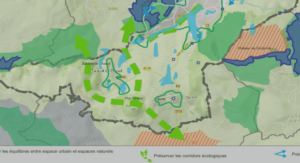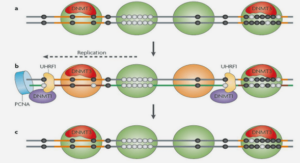Earth’s atmosphere has been going through changes without precedents in human records. During the last thirty years, the global mean surface temperature has consecutively been warmer decade after decade (IPCC, 2013b; McGuffie & Henderson‐Sellers, 2001). These observed alterations in the climate system and their potential impacts on different aspects of our society emphasized the need to comprehend and evaluate these changes now in order to prepare actions for the future.
The Fifth Assessment Report (AR5) of the Intergovernmental Panel on Climate Change has emphasized the importance of further research on the potential impacts of changes on extreme climate events due to its possible higher impact on society and ecosystems compared to changes in mean climate (Hartmann et al., 2013; IPCC, 2013c). The impact of climate change has been perceived in processes within the hydrological cycle, different studies implied that changes in climate might have been already affecting hydrological events by modifying the intensity and distribution of precipitation as well as the surface and underground runoff (Bates et al., 2008; IPCC, 2012; Kron & Berz, 2007).
Flooding is a constant problem that causes large social, economic and environmental losses around the world. The World Disasters Report (WDR, 2016) pointed out that floods cause more losses than the combination of all other natural hazards. Changes in hydrological regimes can also have impacts on the management of water resources such as hydro-based electricity production. Quebec, province of Canada, possesses significant water resources and they are of great importance as ninety six percent of the province’s electricity consumption is obtained by hydroelectric power stations (CEHQ, 2015; Clavet-Gaumont et al., 2013). As a result of these great potential impacts, the number of studies evaluating the potential effect of climate change on extreme hydrological events has increased dramatically. Hydrological modelling and streamflow forecasting thus play an important role in the global and regional economy and in many aspects of social development (Grey & Sadoff, 2007).
The climate change impacts on hydrology are usually evaluated using the climate model outputs as inputs for the hydrological models. Lately, numerous General Circulation Models (GCMs) have been developed and downscaled with higher-resolution Regional Climate Models (RCMs) that can improve the process representation of climate variables such as precipitation (Teutschbein & Seibert, 2010). Therefore, researchers have thrived to improve climate model’s spatial resolution as it is thought that the finer scales will allow for a better representation of the hydrological processes for studies at the catchment scale.
The increase in spatial resolution also increases the climate model and hydrological model simulation times, which raises the need to evaluate how increasing resolution in climate modelling, impacts the hydrological streamflow simulations. In other words, it is necessary to analyse what are the effects of the higher climate model resolution on the simulation of hydrological extremes such as floods. Thus, to address this issue, this study aims to analyse the spatial resolution impact of the Canadian Regional Climate Model (CRCM) spatial resolution on the hydrological modelling of rainfall-driven floods in southern Quebec.
Floods and future trends
Floods are defined by the Special Report on “Managing the Risks of Extreme Events and Disasters to Advance Climate Change Adaptation” of the Intergovernmental Panel on Climate Change (IPCC SREX) as: “the overflowing of the normal confines of a stream or other body of water or the accumulation of water over areas that are not normally submerged. Floods include river (fluvial) floods, flash floods, urban floods, pluvial floods, sewer floods, coastal floods, and glacial lake outburst floods” (IPCC, 2012; Kundzewicz et al., 2013). Climatic and non-climatic factors can influence a flood occurrence, for instance processes such as heavy precipitation, long-lasting precipitation, snowmelt, land use changes or a dam failure, making the assessment of flood causes a complex and difficult task (Bates et al., 2008; Field, 2012).
The change in climate due to global warming is evident, and there is great certainty that will continue to affect the hydrological cycle (Arsenault et al., 2013; J. Hansen et al., 2016; IPCC, 2013b; Mareuil et al., 2007; Troin et al., 2016). The observed global warming has been related with numerous elements of the hydrological systems such as changes in precipitation intensity and extremes, alteration on the melting of snow and ice, increases in water vapour, evaporation and runoff variations (Bates et al., 2008; Coppola et al., 2016; Vormoor et al., 2016; Wehner et al., 2017) .
The hydrologic system has not only been affected in mean conditions but also in the occurrence of extreme events such as floods bringing potential consequences to vulnerable regions (Riboust & Brissette, 2015). Therefore, it has become essential to assess the impacts of climate change on the hydrologic cycle and any modification to the risks related to flood events.
Efforts have been made recently to examine the impacts of climate change on flood intensity and occurrence at different regional scales around the world. For example, Dankers and Feyen (2008) and Lehner et al. (2006) carried out continental scale studies over Europe. Smaller scale studies have also been explored with national flood analyses such as the study by Veijalainen et al. (2010) over Finland. However, the projected flood trends at those scales were unclear, underlining the need for a more coherent assessment at local scales (Hall et al., 2014). Thus, studies at catchment scale have considerably increased in numbers over the last years (Chen et al., 2011; Graham et al., 2007; Kundzewicz et al., 2014; Minville et al., 2008; Riboust & Brissette, 2015). These case studies usually estimate climate change impacts by feeding GCM or RCM climate projections with hydrological models to produce estimates of future streamflow and analysing the uncertainties involved. However, due to the limited amount of evidence and considerable uncertainties involved, there is still low confidence in projections of future changes on flood magnitude and frequency (Kundzewicz et al., 2014).
Floods vary in space and time, complicating their detection and attribution (Wehner et al., 2017). For this reason, higher spatial resolution of forcing data is expected to increase the coherency in the assessment of these phenomena. This highlights the importance to further research on the effects of increasing spatial resolutions of climate simulations on the hydrological modelling of floods.
Hydrological modelling
Currently there is an abundant variety of hydrological models, which are based on approximations of the hydrological system processes and provide an estimate of the streamflow within a watershed (Beven, 2011; Singh & Woolhiser, 2002). The different ways of simplifying systems have shaped different types of models. There are mainly two types, deterministic models and stochastic models (Te Chow, 1988).
The deterministic model is characterized because it does not consider randomness, so a given simulation always produces the same results. Deterministic models use parameters in order to represent hydrological processes. These hydrological models are also called conceptual when non-physically based elements are included (Singh & Woolhiser, 2002). At the same time, within the deterministic models, there are the lumped models and spatially distributed models. Lumped models consider mean values throughout the catchment treating it as a single unit while distributed model consider the spatial variability of the variables (Beven, 2011; Pechlivanidis et al., 2011). The stochastic model, unlike the deterministic, considers partial randomness, that is, it produces predictions. In some cases, the randomness of hydrological processes in a model is high, so it is considered completely random, in which case the model is called probabilistic (Beven, 2011; Te Chow, 1988). For the scope of this project, two deterministic lumped conceptual models were selected.
INTRODUCTION |




